部编初一年级英语下册电子教案七下Unit8二课时
- 格式:doc
- 大小:4.78 MB
- 文档页数:13
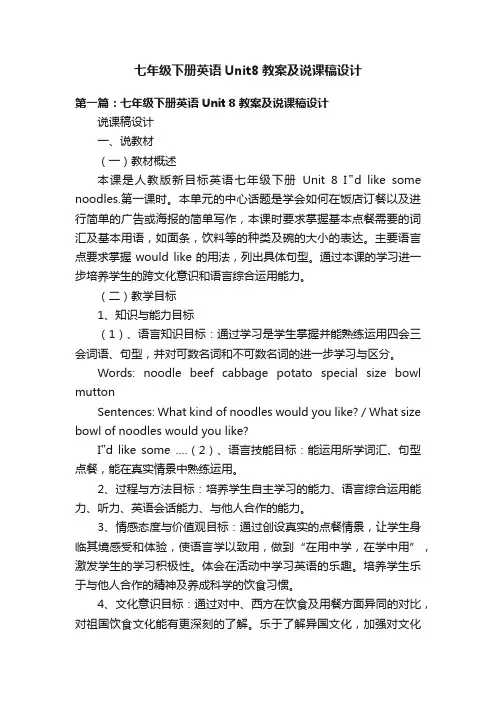
七年级下册英语Unit8教案及说课稿设计第一篇:七年级下册英语Unit 8教案及说课稿设计说课稿设计一、说教材(一)教材概述本课是人教版新目标英语七年级下册Unit 8 I‟d like some noodles.第一课时。
本单元的中心话题是学会如何在饭店订餐以及进行简单的广告或海报的简单写作,本课时要求掌握基本点餐需要的词汇及基本用语,如面条,饮料等的种类及碗的大小的表达。
主要语言点要求掌握would like的用法,列出具体句型。
通过本课的学习进一步培养学生的跨文化意识和语言综合运用能力。
(二)教学目标1、知识与能力目标(1)、语言知识目标:通过学习是学生掌握并能熟练运用四会三会词语、句型,并对可数名词和不可数名词的进一步学习与区分。
Words: noodle beef cabbage potato special size bowl muttonSentences: What kind of noodles would you like? / What size bowl of noodles would you like?I‟d like some ….(2)、语言技能目标:能运用所学词汇、句型点餐,能在真实情景中熟练运用。
2、过程与方法目标:培养学生自主学习的能力、语言综合运用能力、听力、英语会话能力、与他人合作的能力。
3、情感态度与价值观目标:通过创设真实的点餐情景,让学生身临其境感受和体验,使语言学以致用,做到“在用中学,在学中用”,激发学生的学习积极性。
体会在活动中学习英语的乐趣。
培养学生乐于与他人合作的精神及养成科学的饮食习惯。
4、文化意识目标:通过对中、西方在饮食及用餐方面异同的对比,对祖国饮食文化能有更深刻的了解。
乐于了解异国文化,加强对文化差异的理解与认识。
5、学习策略目标:通过学习,使学生在一定程度上形成自主学习、探究学习、合作学习的习惯,有效培养学生的英语思维能力。
(三)、教学重点与难点重点:1、学习日常生活中有关食物的名称。
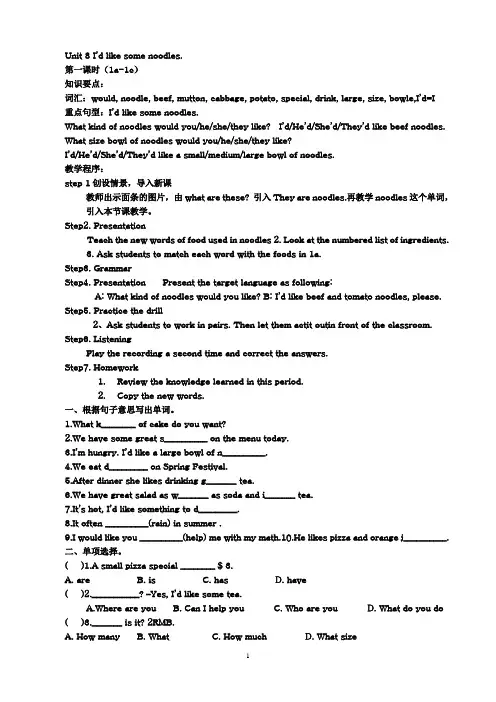
Unit 8 I’d like some noodles.第一课时(1a-1c)知识要点:词汇:would, noodle, beef, mutton, cabbage, potato, special, drink, large, size, bowle,I’d=I重点句型:I’d like some noodles.What kind of noodles would you/he/she/they like? I’d/He’d/She’d/They’d like beef noodles. What size bowl of noodles would you/he/she/they like?I’d/He’d/She’d/They’d like a small/medium/large bowl of noodles.教学程序:step 1创设情景,导入新课教师出示面条的图片,由what are these? 引入They are noodles.再教学noodles这个单词,引入本节课教学。
Step2. PresentationTeach the new words of food used in noodles 2. Look at the numbered list of ingredients.3. Ask students to match each word with the foods in 1a.Step3. GrammarStep4. Presentation Present the target language as following:A: What kind of noodles would you like? B: I’d like beef and tomato noodles, please. Step5. Practice the drill2、Ask students to work in pairs. Then let them actit outin front of the classroom. Step6. ListeningPlay the recording a second time and correct the answers.Step7. Homework1.Review the knowledge learned in this period.2.Copy the new words.一、根据句子意思写出单词。
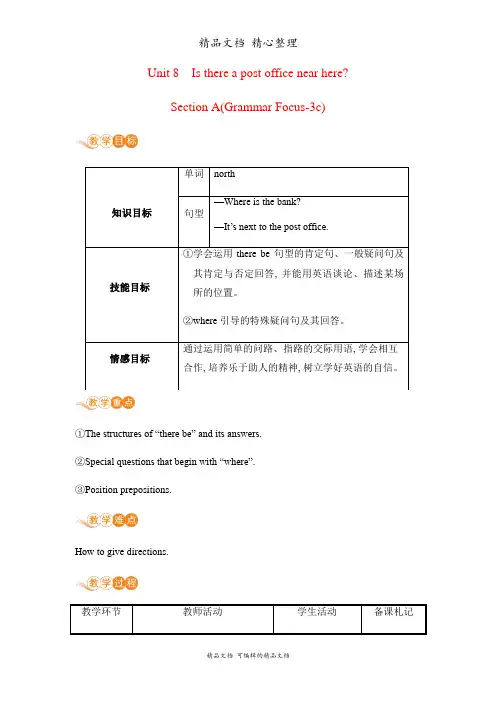
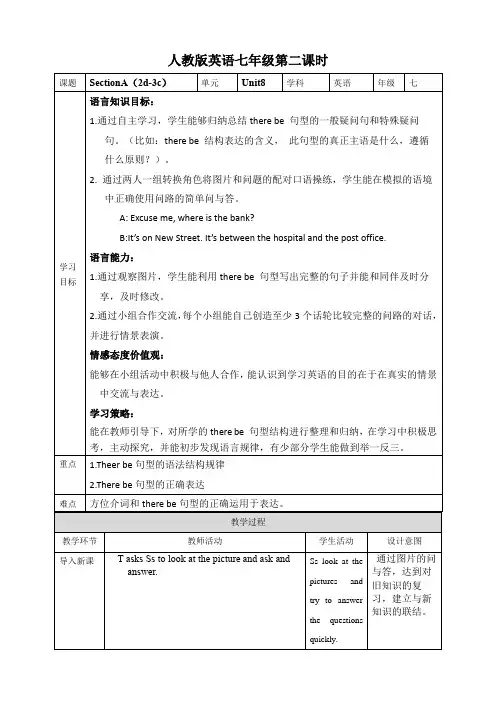
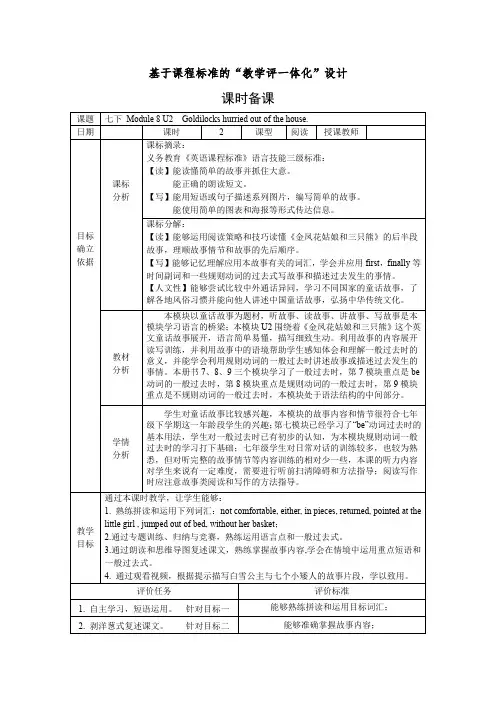
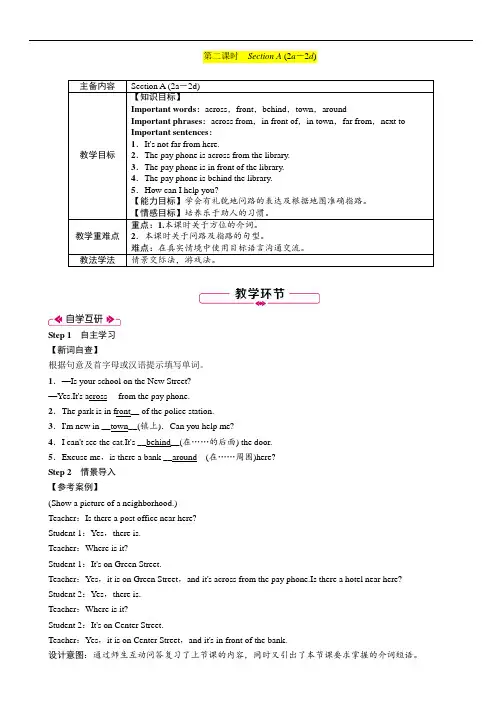
第二课时Section A (2a-2d)主备内容Section A (2a-2d)教学目标【知识目标】Important words:across,front,behind,town,aroundImportant phrases:across from,in front of,in town,far from,next to Important sentences:1.It's not far from here.2.The pay phone is across from the library.3.The pay phone is in front of the library.4.The pay phone is behind the library.5.How can I help you?【能力目标】学会有礼貌地问路的表达及根据地图准确指路。
【情感目标】培养乐于助人的习惯。
教学重难点重点:1.本课时关于方位的介词。
2.本课时关于问路及指路的句型。
难点:在真实情境中使用目标语言沟通交流。
教法学法情景交际法,游戏法。
Step 1自主学习【新词自查】根据句意及首字母或汉语提示填写单词。
1.—Is your school on the New Street?—Yes.It's across__ from the pay phone.2.The park is in front__ of the police station.3.I'm new in __town__(镇上).Can you help me?4.I can't see the cat.It's __behind__(在……的后面) the door.5.Excuse me,is there a bank __around__(在……周围)here?Step 2情景导入【参考案例】(Show a picture of a neighborhood.)Teacher:Is there a post office near here?Student 1:Yes,there is.Teacher:Where is it?Student 1:It's on Green Street.Teacher:Yes,it is on Green Street,and it's across from the pay phone.Is there a hotel near here? Student 2:Yes,there is.Teacher:Where is it?Student 2:It's on Center Street.Teacher:Yes,it is on Center Street,and it's in front of the bank.设计意图:通过师生互动问答复习了上节课的内容,同时又引出了本节课要求掌握的介词短语。
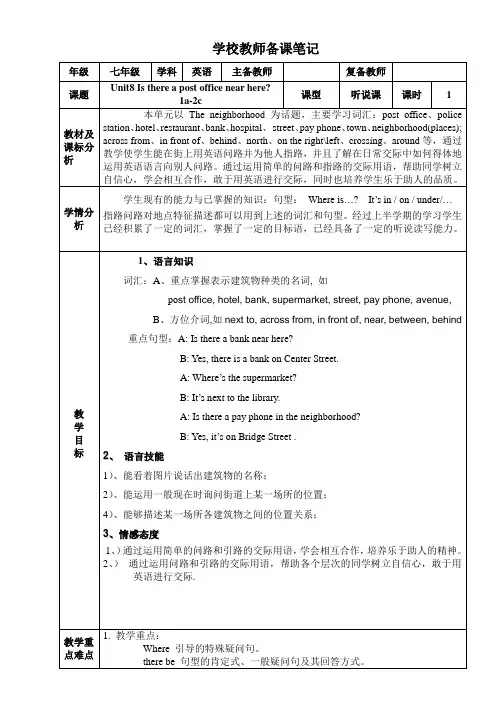
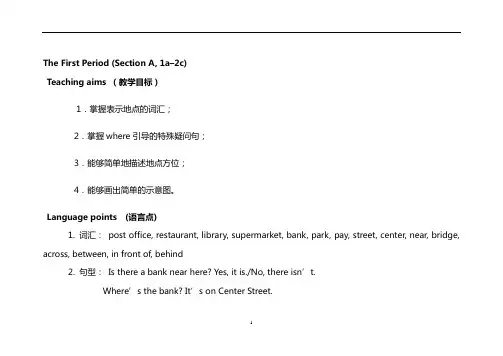
The First Period (Section A, 1a–2c)Teaching aims (教学目标)1.掌握表示地点的词汇;2.掌握where引导的特殊疑问句;3.能够简单地描述地点方位;4.能够画出简单的示意图。
Language points (语言点)1. 词汇:post office, restaurant, library, supermarket, bank, park, pay, street, center, near, bridge, across, between, in front of, behind2. 句型:Is there a bank near here? Yes, it is./No, there isn’t.Where’s the bank? It’s on Center Street.Difficulties (教学难点)1. Where引导的特殊疑问句。
2. 肯定陈述。
3. 表示方向的介词。
Teaching steps (教学步骤)1. Warm-up and revision(课堂热身和复习)(1)Daily greetings to the Ss(2) Revision (复习)【教学设计说明】本单元主要话题是问路,因此从复习地点名词入手,进而自然的过渡到本单元的话题,这样以旧带新能帮助学生扩展思维。
2. Presentation (呈现新知识)(1) Present the new wordsShow pictures of different places and help Ss to understand the new words.Explain prepositions of place to Ss using the pictures of the mouse and the ball.【教学设计说明】图片教学法是呈现新知识最简单有效的方法之一,学生通过图片,能更价值观的理解新单词的含义。
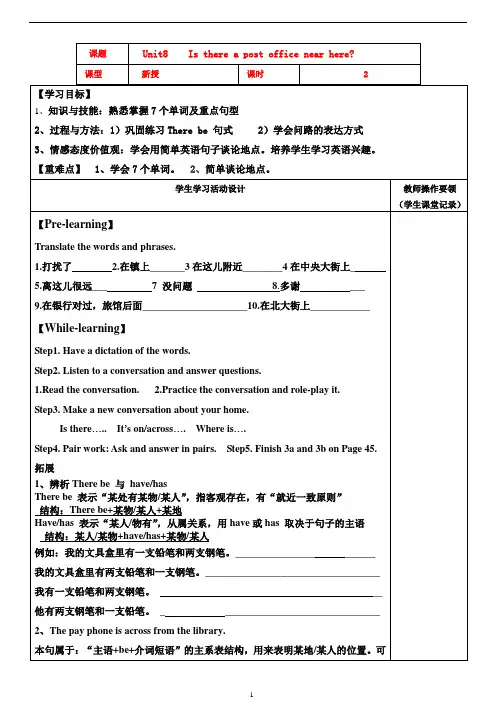
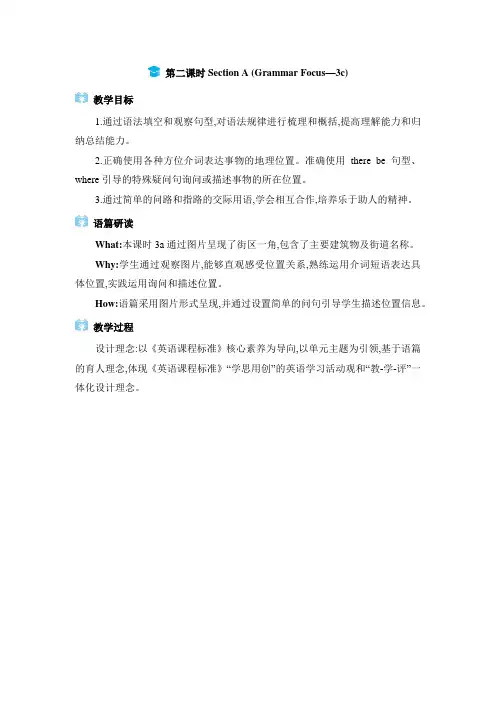
第二课时Section A (Grammar Focus—3c)
教学目标
1.通过语法填空和观察句型,对语法规律进行梳理和概括,提高理解能力和归纳总结能力。
2.正确使用各种方位介词表达事物的地理位置。
准确使用there be句型、where引导的特殊疑问句询问或描述事物的所在位置。
3.通过简单的问路和指路的交际用语,学会相互合作,培养乐于助人的精神。
语篇研读
What:本课时3a通过图片呈现了街区一角,包含了主要建筑物及街道名称。
Why:学生通过观察图片,能够直观感受位置关系,熟练运用介词短语表达具体位置,实践运用询问和描述位置。
How:语篇采用图片形式呈现,并通过设置简单的问句引导学生描述位置信息。
教学过程
设计理念:以《英语课程标准》核心素养为导向,以单元主题为引领,基于语篇的育人理念,体现《英语课程标准》“学思用创”的英语学习活动观和“教-学-评”一体化设计理念。
续表
续表
板书设计
作业设计
基础型作业:Read and recite the sentences in Grammar Focus.
实践型作业:Draw a map of places on your street and make at least five sentences to describe these places.
拓展型作业:Walk around your school. Write a passage to describe your school and your school life.
教学反思。
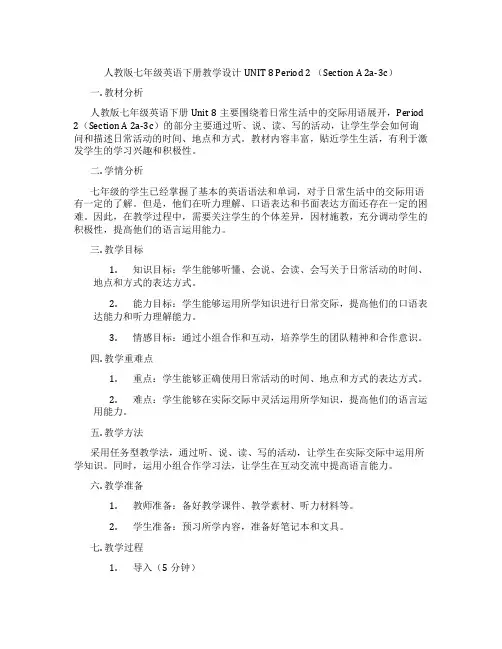
人教版七年级英语下册教学设计UNIT 8 Period 2 (Section A 2a-3c)一. 教材分析人教版七年级英语下册Unit 8主要围绕着日常生活中的交际用语展开,Period 2(Section A 2a-3c)的部分主要通过听、说、读、写的活动,让学生学会如何询问和描述日常活动的时间、地点和方式。
教材内容丰富,贴近学生生活,有利于激发学生的学习兴趣和积极性。
二. 学情分析七年级的学生已经掌握了基本的英语语法和单词,对于日常生活中的交际用语有一定的了解。
但是,他们在听力理解、口语表达和书面表达方面还存在一定的困难。
因此,在教学过程中,需要关注学生的个体差异,因材施教,充分调动学生的积极性,提高他们的语言运用能力。
三. 教学目标1.知识目标:学生能够听懂、会说、会读、会写关于日常活动的时间、地点和方式的表达方式。
2.能力目标:学生能够运用所学知识进行日常交际,提高他们的口语表达能力和听力理解能力。
3.情感目标:通过小组合作和互动,培养学生的团队精神和合作意识。
四. 教学重难点1.重点:学生能够正确使用日常活动的时间、地点和方式的表达方式。
2.难点:学生能够在实际交际中灵活运用所学知识,提高他们的语言运用能力。
五. 教学方法采用任务型教学法,通过听、说、读、写的活动,让学生在实际交际中运用所学知识。
同时,运用小组合作学习法,让学生在互动交流中提高语言能力。
六. 教学准备1.教师准备:备好教学课件、教学素材、听力材料等。
2.学生准备:预习所学内容,准备好笔记本和文具。
七. 教学过程1.导入(5分钟)通过与学生谈论日常活动,如:watching TV, playing sports, doing homework等,引出本节课的主题——询问和描述日常活动的时间、地点和方式。
2.呈现(10分钟)展示教材2a的图片,让学生观察并回答问题:“What are they doing? Where are they?” 引导学生学会用一般现在时描述正在进行的动作。
Unit 8 How was your school trip?Page 47 Section A 1a~1cI.Teaching Aims and Demands1.Knowledge ObjectsKey vocabulary; Target language.2.Abiklity ObjectsListening, speaking, writing and cooperating skills.1.Moral ObjectWhat you do today is what you do tomorrow.II.Teaching Key Points1.Key vocabularyaquarium, zoo, seals, sharks, photos, souvenir, ate, took, hung out.2.Target languageDid you go to the zoo?No, I didn’t. I went to the aquarium.Were there any aharks?No, there weren’t any sharks, but there were some really smart seals.III. Teaching Difficulty:Spoken practice.IV. Teaching MethodsOral practising, listening, writing, asking and answering methods; Pairwork.V. Teaching ProceduresStep I Greet the class.Step II Today we are going to learn Uint 8 How was your school trip?During this unit we will learn more ways to talk about things that happened yesterday, last week or last year. Now I’d like to ask some questions about things you did yesterday or last week.Warming – up:Ask different students questions about things they did yesterday or last week using verbs they have already studied.Ask the students to give the short answers, Yes, I did . No, I didn’t .Yes, I was. No, I wasn’t. Use these verbs: do/did, is/was, are/were, buy/bought, go/went, and see/saw. Review the present and past of some verbs students have already studied. Remember to use only these verbs: do/did, is/was, are/were, buy/bought, go/went, and see/saw. Step III Show new words on the screenaquarium shark seal souvenirLead the students read the words above and add some more words needed to teach. Step IV Section A 1aAak students to make separate lists.Ask students to read their lists to the class. On the board, make a list of all the activities students talk about using a past verb and the activity. Point to the items and ask different students to read the items to the class.Step V 1bPoint out the picture and the list of activities. Read the instructions.Listening carefully and circle only the things you hear on the recording .Check the answers.Step VI 1c PairworkAsk students to look at the picture in Activity 1a. Then point out the sample comversation in Activity 1c. Ask two students to read it to the class.Say, Now work with a partner. Make your own conversations about the people in the picture.Ask several pairs to present one or more of their converwations to the class.Step VII GameDivide the class into two teams. Name one team “past”and the other “present”. The “past ”team will talk about things that happened last week or last year. The “present”team will talk about things that happen every day. The “past ”team starts by saying a sentence. The “present”team has to change the sentence into a “present”sentence. For example, I went swimming yesterday becomes I go swimming every day. The “present”team to change. Each team gets one point for changing a sentence correctly.Step VIII SummaryToday we have learned how to talk about what you did on your last school trip. This is about something happened in the past. And now we know how to say it in English. We have to work hard every day then we could make progress every day.Step IX HomeworkReview the Activity 1a. Practice the Activity 1b with yout partner.Step X Blackboard DesignUnit 8 How was your school trip?Did you go to the zoo?No, I didn’t. I went to the aquarium.Were there any aharks?No, there weren’t any sharks,but there were some really smart seals.Step XI Teaching reflection:。
七年级下册Unit 8Unit 8 Is there a post office near here? Section A 1a-2c1.整体设计思路、指导依据说明整体设计思路:本课时主要涉及话题为neighborhood,话题的生活化和实用性要求教学活动的设计应以交际语言教学、情境性教学和任务型语言学习为理论指导,在此基础上进行听说的训练。
在本教学设计中,采用“主线”式教学模式,设置了以“neighborhood”为话题的教学主线,将整堂课分为三个任务,设置三大“子话题”,分别为“names of buildings”、“prepositions of location”和“ask for and give directions on the street”,而教材中的教学内容则分别被划分入各个“子话题”。
课堂中例如“猜单词”、“大家来找茬”、以及“画地图并介绍身边的社区”等主要活动,使学生能用方位介词来描述某一场所中各个建筑物之间的关系,从而达到听说能力得到综合操练及运用,使得“学为所用”,符合“任务型”教学理念。
指导依据说明:为体现《英语课程标准》(2011版)“整体设计目标,面向全体学生;丰富课程资源,拓展学用渠道”的基本理念,我设计了多个学生喜欢、贴近生活的活动,这些活动能调动不同水平学生现有的知识储备,学生能够就熟悉的话题进行简单的交流,大大激发了学生的学习兴趣和交流欲望。
通过这一系列的课堂活动,学生能够形成初步的与该话题相关的综合语言运用能力,锻炼了理解和表达的技能,即听说两方面的技能,从而学生能够真正在生活中运用英语知识。
2.教学背景分析教学内容分析:本单元以“ask for and give directions on the street”为主题,Section A主要为各建筑物名称和方位介词的学习和运用,并自然引出询问某一场所位置的两个重要句型“where’s the…? Is there a … near here? ”以及简单的回答。
七年级英语下册新版人教新目标版Section A 第2课时(2a~3c)自主学习方案1.自学生词,并记住拼读及拼写。
2.预习课本找出重点短语及句子。
(见学案自学导练内容)3.读记后完成自学导练内容。
课堂导学方案Step1 情景导入展示图片,然后师生进行对话。
(最后利用多媒体课件)T:Is there a library near here?S:Yes,there is.T:Where is it?S:It’s on Green Street.T:Yes,it is on Green Street,and it’s across from the pay phone. Is there a hotel near here?S:Yes,there is.T:Where is it?S:It’s on Center Street.T:Yes,it is on Center Street,and it’s in front of the bank.环节说明:通过师生互动问答复习了上节课的内容,同时又引出了本节课要求掌握的介词短语。
Step 2完成教材2a—2c的任务1.大声朗读2a的句子并标出其中的介词短语识记。
(3分钟)2.认真观察图片,将句子和图片匹配,小组订正答案,完成2a。
(3分钟)3.识记方框中的表示方位的词或短语,然后认真听录音,完成选词填空,集体核对答案。
学生识记句型,体会表示方位的介词或介词短语的用法,完成 2b。
(3分钟)4.根据43页1a图片上的建筑物位置,仿照2c形式来练习对话。
两人一组,根据图片和提示,自编对话,注意交换角色。
(5分钟)5.小结训练。
(3分钟)用介词填空:(1)The library is across from the bank.(2)The bank is between the supermarket and the hospital.(3)My house is on that small street.(4)The restaurant is next to the park.(5)There is a beautiful park in front of the bank.环节说明:通过2a的学习让学生了解介词短语的用法,通过2b、2c的学习有助于提高学生的听力和口语能力。
七年级英语下学期Unit 8教案一、教学内容:Unit 8 SectionA1a-1c; Section B1a二、教材分析:世界各地的人对于食品的口味与习惯都各不相同,本单元围绕food介绍了中国食品的特色及相关知识。
围绕What would you like?等问题,学习“想要什么”的表达。
三、学生主体性的分析:学生这节课的自主性学习较强,因为食品是生活必需品,他们对食品和中西方文化差异很有兴趣,有较强的求知欲和表现欲四、设计理念:1.学生是学习活动的主体,教师是学生活动的组织者和引导者。
在英语教学中,把英语课程生活化,把一个个教学目标活动化,在活动中掌握学习方式,充分发挥师生双方在教学中的主动性和创造性。
2.本课采用任务型的教学模式,把语言应用的基本词汇和表达法转为具有实践意义的课程任务,学生在完成任务的过程中,通过感知、体验、实践、参与创作等方式,完成任务目标,感受成功。
3.小组合作学习是学生学习的主要形式,让学生在自主创作的过程中,自主地表达,自主地学习,实现对知识的融合,信息的交流,资源的共享,为学生搭建展示自我的平台。
教师在学生展示过程中适时给予肯定和赞扬,有利于增进师生感情,建立民主平等和谐的师生关系。
五、教学目标:知识目标:1)学习并掌握would, I’d, noodle, beef, mutton, cabbage, potato, special, juice, dumpling, porridge, tea, green tea, rice, soup, onion, fish等单词。
2)能听懂会说What would you like? What kind of noodles would you like? 并能在实际情景中运用。
能力目标:能用本单元的句型创造性的自编对话,培养学生自学能力、阅读能力,提高学生听的能力,锻炼学生交际能力以及与他人合作的能力情感目标:培养学生英语学习的乐趣和热情,做到在“在用中学,在学中用”。
Unit 8 Is there a post office near here?Section A (1a-2d)Teaching and learning goals1.语言知识目标:1)能掌握以下单词: post office, police station, hotel, restaurant, bank, hospital, street, pay, pay phone, near,across from, in front of, behind , town, around.2)能掌握以下句型:Is / Are there ------? Yes, there is / are. It’s / They’re ------. Where is / are ------? It’s /They’re near / in front of / next to / across / from / behind ------.”.2.能力目标:学生能够用英语询问和正确地指示地点方位。
3.情感态度价值观目标:在询问或指示街道方向的活动中,体会英语交流的乐趣,并在日常生活中学会帮助他人;做到“在用中学、在学中用”。
Teaching and learning stepsStep 1Previewing and testing1. Review names of places .2.Review prepositions of places and sing the preposition songhotelpost office police stationstreetroad townhospitalrestaurantbankPreposition song (链接网址)/v_show/id_XNjQ2OTkwNzYw.html?tpa=dW5pb25faWQ9MTAyMjEzXzEwMDAwMl8wM V8wMQ3. Look at the picture and practice in pairs.S1: Is there a ball on the table?S1: Are there any books in the schoolbag?S2: No, there aren’t .(设计意图:通过这样一个活动很好地复习并落实地点名词和方位介词,为下面的学习扫除词汇障碍。
)Test in class一.Put the following into English orally, and then write them down without looking at the book.1. Put the phrases into English.(1)在---前面______________ (2)在---对过_______________ (3)警察局_____________(4)邮局________________ (5)紧挨着________________ (6)在……周围________________2. Put the sentences into English.(1) —这儿附近有医院吗?—有,在大桥街上。
________________________________________(2) 付费电话就在图书馆对面。
________________________________(3) 警察局在餐馆和医院之间。
______________________________________(4) —医院在哪儿?—就在警察局隔壁。
____________________________________________(5) —中心街在什么地方?离这儿不远。
—我可以步行带你过去.____________________________________________________________(6) 付费电话附近有医院吗?___________________________________________二.Check the preview. Let some students read their answers in front of the class. If he/she can’t answer, other students can give him/her some help.(设计意图:通过课前预习可以使学生更有针对性的学,老师更有针对性的教,而且还可以让学生养成一个良好的学习习惯。
检测预习内容还可以高效地促进学生对基础知识的巩固和基本运用能力的提高)Step2. Warming up and leading inT: Boys and girls! Let’s have a competition. When you see the picture s, please tell me what they are. You can stand up without putting up your hand s. Then I’ll give you one mark. Let’s see which group is the best.T: You are all wonderful! Now, let’s come to 1a.Please match the words with the places in the picture.(设计意图:把简单的内容用竞赛的方式呈现,这样可以充分调动学生的积极性和主动性,使全体同学都快速进入学习状态。
在竞赛过程中要更多地倾向关注后进生。
)Step3. Presentation1. Ask students some questions.T: What’s the name of the road in front of our school?Ss: Changjiang Road.T: Is there a hospital near our school?S1: Yes, there is. It’s on Taishan Road.T: Is there a post office near our school?S2: No, there isn’t.T: Are there any restaurants near our school?S3: Yes, there are. They’re on Deren Road.T: Are there any banks near our school?S4: Yes, there is one along Xizhong Square (奚仲广场) . It is next to Quanxinhuating(泉兴华庭).If the student can’t answer, the teacher gives some help. And write the conversation on the blackboard.(设计意图:根据现实生活中的真实情况与学生进行对话,从而引出目标语言Is/Are there------? Yes, there is / are. No, there isn’t / aren’t. 学生易于理解接受。
)2. Show the pictures to Ss. And practice in pairs.S1: Where’s the soccer ball?S2: It’s on the box.S2: Where’s the soccer ball?S1: It’s in the box.S1: Where’s the soccer ball?S2: It’s under the box..S2: Where’s the soccer ball?S1: It’s next to the box..(设计意图:图片形象直观,且容易引起学生的兴趣。
这样就自然学习了方位介词in, on, next to, in front of, behind, between, across from, near 的具体用法。
为下面的听力训练做了很好的铺垫。
) Step4. Listening Practice Practice I Complete 1a.T:Match the words with the places in the picture. Please look at the picture and finish it quickly.1. post office ____2. police station____3. hotel____T: Where ’s the soccer ball? S6: It ’s behind the box. T: Where ’s the soccer ball? S5: It ’s near the box. S2: Where ’s the soccer ball? S1: It ’s in front of the box. S1: Where ’s the soccer ball? S2: It ’s across from the box.. S1: Where ’s the soccer ball? S2: It ’s between the big box and the small one.5.bank______6.hospital_____7.street_______8.pay phone______9.park_________Get one to tell the answers to them and check..(the answer:1.f 2.a 3.e 4.i 5.c 6.b 7.h8.g9.d)While-listening activities1. Listen for the general idea.T: Boys and girls. Please look at the picture in 1a.What are they talking about? Please listen to the recording and get the main idea.The general idea of the conversations is about _______.A. restaurantB. post officeC. asking the way2. Listen for the specific ideas.T: We know the conversations are about asking the way. What place does the boy want to go? Listen and circle the places please. And then fill in the blanks with the places.(1) Listen and circle the places you hear in 1a.Listening strategy: Pay more attention to the names of places.(2) Complete the conversations according to the tape.Conversation 1A: Is there a _______ on Bridge Street? B: Yes, there is.Conversation 2A: Is there a ____ ____ near here? B: Um, yes, there is. There’s ____ on Long Street.ConversationA: Is there a ________ on Center Street? B: No, there isn’t.Listening strategy: First, let the students go through the blanks. Next, ask them to listen to the recording carefully and fill in the blanks.Post-listening activities1. Listen to the tape and repeat.2. Let students ask and answer questions about the other places in 1a in pairs.For example:A: Is there ------near here?Practice IIWhile-listening activities1. Complete 2a.(1) Let students look at the pictures in 2a and match the sentences with the pictures.(2) Check the answers.(3) Let students read the sentences in 2a aloud.(4) Let several students read the sentences in front of the class.(设计意图:让学生大声朗读来巩固next to, in front of, between, behind, across from, on的用法,为下面的听力填空做准备。